
The Gay Divorcee is a 1934 American musical film directed by Mark Sandrich and starring Fred Astaire and Ginger Rogers. It also features Alice Brady, Edward Everett Horton, Eric Blore, and Erik Rhodes. The screenplay was written by George Marion Jr., Dorothy Yost, and Edward Kaufman. It was based on the Broadway musical Gay Divorce, written by Dwight Taylor with Kenneth S. Webb and Samuel Hoffenstein adapting an unproduced play by J. Hartley Manners.

Phyllis Virginia "Bebe" Daniels was an American actress, singer, dancer, writer, and producer.

Babes in Toyland is a Laurel and Hardy musical Christmas film released on November 30, 1934. The film is also known by the alternative titles Laurel and Hardy in Toyland, Revenge Is Sweet, and March of the Wooden Soldiers, a 73-minute abridged version.

Girl Crazy is a 1930 musical by George Gershwin with lyrics by Ira Gershwin and book by Guy Bolton and John McGowan. Ethel Merman made her stage debut in the first production and co-lead Ginger Rogers became an overnight star. Rich in song, it follows the story of Danny Churchill who has been sent to fictional Custerville, Arizona, to manage his family's ranch. His father wants him there to focus on matters more serious than alcohol and women but Danny turns the place into a dude ranch, importing showgirls from Broadway and hiring Kate Forthergill as entertainer. Visitors come from both coasts and Danny falls in love with the local postmistress, Molly Gray.

Wheeler & Woolsey were an American vaudeville comedy double act who performed together in comedy films from the late 1920s. The team comprised Bert Wheeler (1895–1968) of New Jersey and Robert Woolsey (1888–1938) of Illinois.
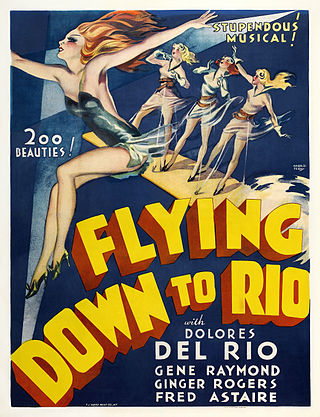
Flying Down to Rio is a 1933 American pre-Code RKO musical film famous for being the first screen pairing of Fred Astaire and Ginger Rogers, although lead actors Dolores del Río and Gene Raymond received top billing. Among the featured players are Franklin Pangborn and Eric Blore. The songs in the film were written by Vincent Youmans (music), Gus Kahn and Edward Eliscu (lyrics), with musical direction and additional music by Max Steiner. During the 7th Academy Awards, the film was nominated for the new category of Best Original Song for "Carioca", but it lost to "The Continental" from The Gay Divorcee, the next Astaire and Rogers film.
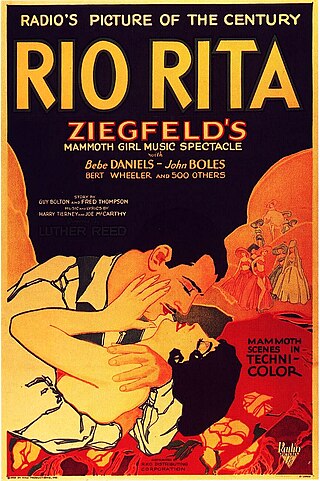
Rio Rita is a 1929 American pre-Code RKO musical comedy starring Bebe Daniels and John Boles along with the comedy team of Wheeler & Woolsey.. The film is based on the 1927 stage musical produced by Florenz Ziegfeld, which originally united Wheeler and Woolsey as a team and made them famous. The film was the biggest and most expensive RKO production of 1929 as well as the studio's biggest box office hit until King Kong (1933). Its finale was photographed in two-color Technicolor. Rio Rita was chosen as one of the 10 best films of 1929 by Film Daily.

John Boles was an American singer and actor best known for playing Victor Moritz in the 1931 film Frankenstein.

Rio Rita is a 1927 stage musical with a book by Guy Bolton and Fred Thompson, music by Harry Tierney, lyrics by Joseph McCarthy, and produced by Florenz Ziegfeld. This musical united Bert Wheeler and Robert Woolsey as a comedy team and made them famous.
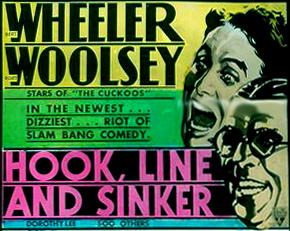
Hook, Line and Sinker is a 1930 American pre-Code slapstick comedy directed by Edward F. Cline from a screenplay by Ralph Spence and Tim Whelan. It was the third starring vehicle for the comedy team of Wheeler & Woolsey, and also featured Dorothy Lee. It would be one of the largest financial successes for RKO Pictures in 1930.

Half Shot at Sunrise is a 1930 American pre-Code comedy film starring the comedy duo Wheeler & Woolsey and Dorothy Lee. Their fourth film together, it was the second starring vehicle for the two, following the success of The Cuckoos, which had been released earlier in 1930. Directed by Paul Sloane, from a screenplay by Anne Caldwell, James Ashmore Creelman, Ralph Spence, and Fatty Arbuckle, which had been tailored to highlight the comedic talents of Wheeler and Woolsey. In 1958, the film entered the public domain in the United States because the claimants did not renew its copyright registration in the 28th year after publication.
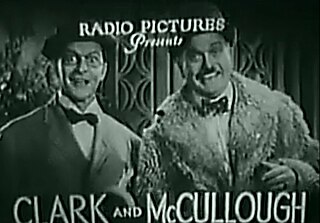
Robert Edwin Clark, known as Bobby Clark, was an American minstrel, vaudevillian, performer on stage, film, television and the circus. Known for his painted-on eyeglasses, he was part of a comedy team with Paul McCullough for 36 years.

Paul Johnston McCullough was an American actor and comedian who was one half of the comedy duo Clark and McCullough, along with fellow comedian Bobby Clark.

Hit the Deck is a 1930 American pre-Code musical film directed by Luther Reed and starring Jack Oakie and Polly Walker, with Technicolor sequences. It was based on the 1927 musical Hit the Deck, which was itself based on the 1922 play Shore Leave by Hubert Osborne. It was one of the most expensive productions of RKO Radio Pictures up to that time, and one of the most expensive productions of 1930. This version faithfully reproduced the stage version of the musical.

The Cuckoos is a 1930 American Pre-Code musical comedy film released by RKO Radio Pictures and partially filmed in two-strip Technicolor. Directed by Paul Sloane, the screenplay was adapted by Cyrus Wood from the 1926 Broadway musical The Ramblers by Guy Bolton, Bert Kalmar and Harry Ruby. The film stars Bert Wheeler and Robert Woolsey, and while they had appeared on Broadway and in other films together, this was their first time starring as a team. The success of this picture, combined with Rio Rita being their most successful film of 1929, convinced the studio to headline them as the comedy team Wheeler & Woolsey, through 1937.

Clark and McCullough were a comedy team consisting of comedians Bobby Clark and Paul McCullough. They starred in a series of short films during the 1920s and 1930s. Bobby Clark was the fast-talking wisecracker with painted-on eyeglasses; Paul McCullough was his easygoing assistant named Blodgett.
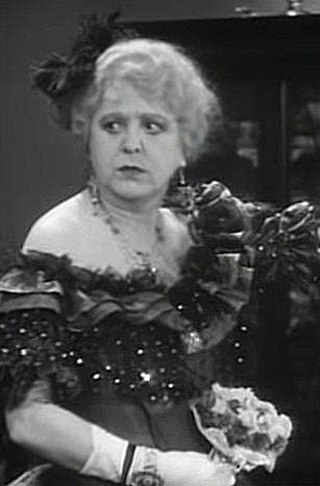
Jobyna Howland was an American stage and screen actress.

Joseph Bridger Cawthorn was an American stage and film comic actor.

RKO Radio Pictures Inc., commonly known as RKO Pictures or simply RKO, was an American film production and distribution company, one of the "Big Five" film studios of Hollywood's Golden Age. The business was formed after the Keith-Albee-Orpheum theater chain and Joseph P. Kennedy's Film Booking Offices of America studio were brought together under the control of the Radio Corporation of America (RCA) in October 1928. RCA executive David Sarnoff engineered the merger to create a market for the company's sound-on-film technology, RCA Photophone, and in early 1929 production began under the RKO name. Two years later, another Kennedy concern, the Pathé studio, was folded into the operation. By the mid-1940s, RKO was controlled by investor Floyd Odlum.

Everett Marshall was an American singer and actor who performed at the Metropolitan Opera, in Broadway revues, and in early musical films.




















